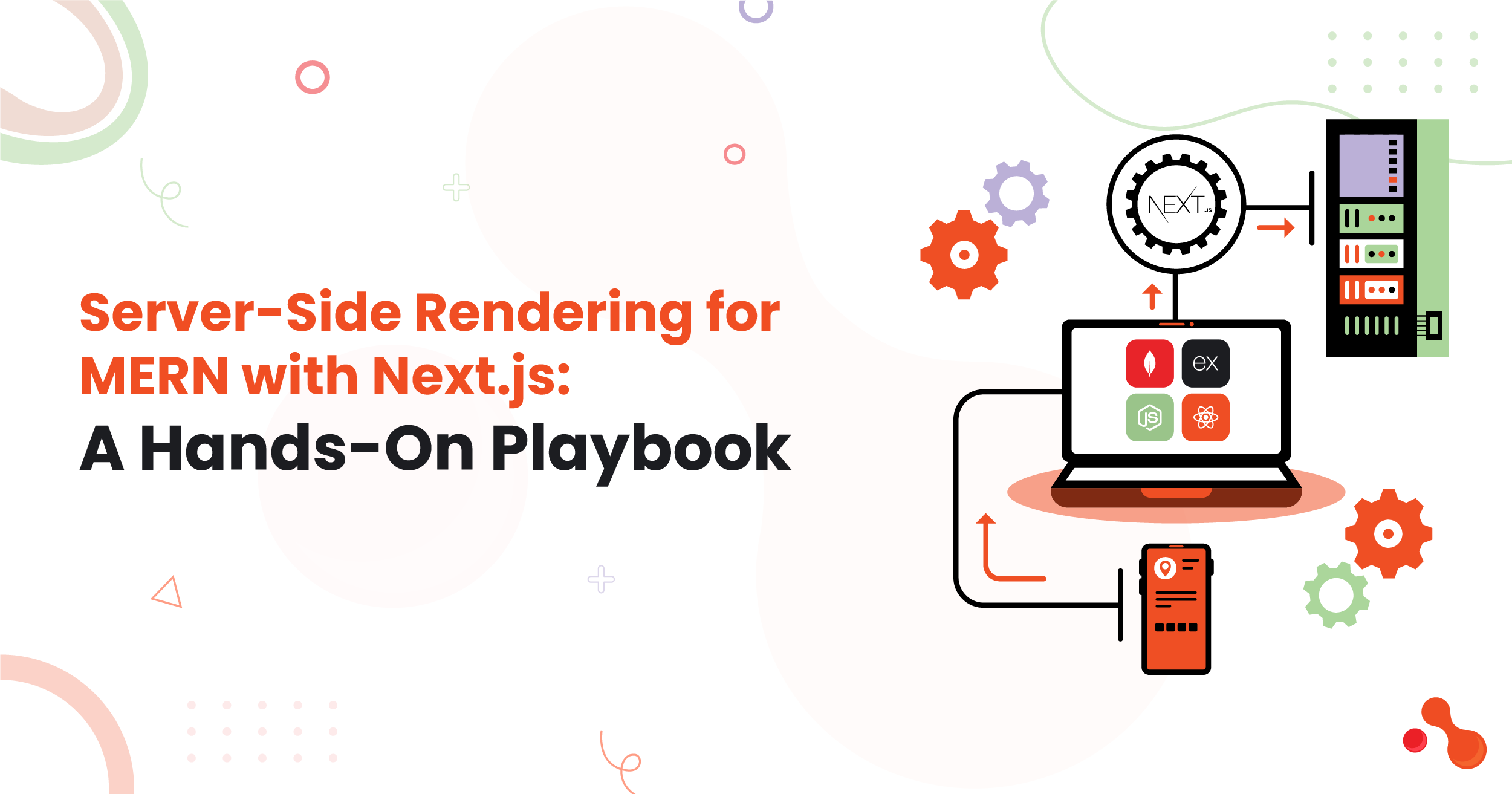Reference :
https://medium.com/@mukesh.ram/introduction-ffe4f6c18b7f
Introduction
Modern product teams chase fast first paint, steady SEO, and predictable delivery. Server Side Rendering MERN stack Next.js delivers that trio. You render pages on the server, ship real HTML on the first response, and hydrate React on the client. Crawlers read content without tricks, users see pixels earlier, and route-level caching trims compute spend strong MERN stack performance optimization without a risky rewrite.
Lets figure this scenario in detail here in this blog!
What is Server-Side Rendering (SSR)?
Search engines and users want real content on the first response. Server Side Rendering MERN stack Next.js delivers that result. The server renders a React tree, returns HTML, and the browser paints pixels immediately.
The client then hydrates the page and resumes interaction. You gain speed, stronger crawlability, and cleaner share previews solid MERN stack performance optimization without a risky rewrite.
What “server-rendered” truly means?
- The server runs SSR with React and Node.js, builds HTML for the route, and sends a complete document.
- The browser shows content instantly, then boots client scripts to enable clicks and dynamic state.
- You can stream chunks for long pages, so users see headers and above-the-fold content early.
- You control caching at the edge, which trims compute and cuts tail latency.
Why teams pair SSR with Next.js?
- Next.js for full stack JavaScript wiresrouting, data fetching, and streaming in one framework.
- File-based routes keep structure clear; server components reduce client bundle weight.
- Incremental revalidation updates HTML on a schedule, so hot pages stay fresh without heavy compute.
Where SSR shines in MERN?
- Marketing pages, category lists, product detail, geo-aware landing pages, and blog content.
- Slow networks or underpowered devices that benefit from server-rendered HTML.
- Apps that track Core Web Vitals and SEO as hard targets, not soft wishes.
Overview of MERN Stack and Next.js
You run MongoDB for data, Express + Node for the API layer, and Next.js for the web. Next.js renders React on the server and the client, so SSR with React and Node.js flows naturally. This layout turns one codebase into a fast, crawlable app clean MERN stack performance optimization anchored by Next.js for full stack JavaScript and Server Side Rendering MERN stack Next.js.
Roles and boundaries
- MongoDB: stores documents, indexes hot fields, returns lean projections.
- Express + Node: enforces auth, validates input, shapes responses, logs short error codes.
- Next.js: owns routing, SSR with React and Node.js, streaming, and hydration.
Integration patterns that work
API choice
- Keep a standalone Express service at /api/*.
- Or move endpoints into Next.js Route Handlers for smaller teams.
Data access
- Reuse one Mongo client per process.
- Fetch data inside server components or in getServerSideProps for legacy pages.
Auth
- Use HTTP-only cookies; read sessions in server components.
- Gate routes with middleware and return early on failure.
Caching
- Add incremental revalidation for semi-static pages.
- Use edge caching for HTML when content changes on a schedule.
Folder shape (example)
apps/
web/ # Next.js app router
app/
products/[id]/page.tsx # server component SSR
layout.tsx
api/route.ts # optional route handlers
api/ # Express service (if kept separate)
src/
routes/
models/
packages/
ui/ # shared UI
types/ # shared types
Responsibilities matrix
- Next.js (web): server-render pages, stream above-the-fold HTML, hydrate islands, route traffic through Server Side Rendering MERN stack Next.js.
- API (Express): return stable JSON shapes, cap result size, attach requestId.
- Mongo: serve indexed queries, uphold TTL ontemp collections, back up on schedule.
How SSR Works in a MERN + Next.js Setup?
A request hits your edge, Next.js renders HTML on the server, and the browser paints real content before JavaScript boots. That rhythm defines Server Side Rendering MERN stack Next.js in practice and drives real MERN stack performance optimization.
Edge → Next.js
The load balancer forwards GET /products/123. Next.js selects the route and enters the server component tree.
Data fetch on the server
Server components call the SSR with React and Node.js data layer. You can call an Express endpoint (/api/products/123) or read through a shared Mongo client.
Render and stream
Next.js renders HTML for above-the-fold content and streams chunks so users see pixels early.
Hydration in the browser
The client downloads small JS chunks, hydrates interactive islands, and binds events.
Caching and revalidation
The edge or the Next.js cache stores HTML. Incremental revalidation refreshes stale pages without a full rebuild clean wins for Next.js for full stack JavaScript teams.
Data patterns that keep SSR fast
Server components first.
Fetch data inside server components or route handlers; send lean props to client components.
Stable shapes.
Return compact JSON from Express; include requestId and short error codes for triage.
Indexes always.
Hit Mongo with index-friendly filters and projections; avoid collection scans.
Revalidation windows.
Rebuild HTML on a timer for semi-static pages (e.g., revalidate: 60). Fresh enough for users, light on compute.
// app/products/[id]/page.tsx (server component)
import { getProduct } from “@/lib/api”;
export default async function ProductPage({ params }: { params: { id: string } }) {
const product = await getProduct(params.id); // server-side fetch
return (
<main>
<h1>{product.title}</h1>
<p>{product.price}</p>
</main>
);
}
// app/products/[id]/route.ts (optional Next.js route handler hitting Mongo or Express)
Auth and personalization without slowdowns
- Use HTTP-only cookies. Read session on the server; render user-specific HTML where needed.
- Split pages: public SSR for SEO, client islands for private widgets.
- Short-circuit early when a token fails; return a lean 401 page and skip heavy queries.
Error paths that stay user-friendly
- Wrap page trees with error and loading boundaries.
- On API failure, render a minimal fallback and a retry control; log the error with requestId.
- For hard outages, serve a cached shell and an honest status message.
Deploy and observe with intent
- Tag each release; roll forward with small batches.
- Track FCP, LCP, P95 route latency, and error rate on SSR calls.
- Correlate logs from Next.js, Express, and Mongo by requestId to cut triage time.
Step-by-Step Guide to Implement SSR with Next.js in MERN Stack
You keep boundaries clear, ship real HTML fast, and prepare for growth. The flow fits SSR with React and Node.js, aligns with Next.js for full stack JavaScript, and works for a lean team or a dedicated mean stack developer.
Follow these steps to wire Server Side Rendering MERN stack Next.js cleanly.
1) Create the Next.js app (App Router)
npx create-next-app@latest web –ts –eslint –src-dir
cd web
Enable the App Router in app/. Keep React Server Components as the default.
2) Install runtime deps
npm i mongoose zod
npm i -D @types/node
mongoose → Mongo connection.
zod → input validation at the edge.
Tip: call the API via Route Handlers or a separate Express service; pick one model and stay consistent for MERN stack performance optimization.
3) Set env and config
web/.env.local
MONGO_URL=mongodb+srv://user:***@cluster/db
NODE_ENV=production
Never commit secrets. Load them at runtime.
4) Create a shared Mongo client
web/src/lib/mongo.ts
import mongoose from “mongoose”;
let conn: typeof mongoose | null = null;
export async function getMongo() {
if (conn) return conn;
conn = await mongoose.connect(process.env.MONGO_URL!);
return conn;
}
One client per process reduces churn and lifts throughput for SSR with React and Node.js.
5) Model data with indexes
web/src/models/Product.ts
import { Schema, model, models } from “mongoose”;
const ProductSchema = new Schema(
{ title: String, price: Number, slug: { type: String, index: true } },
{ timestamps: true }
);
export default models.Product || model(“Product”, ProductSchema);
Index hot fields you filter on (e.g., slug).
6) Add a Route Handler for clean data access (optional)
web/src/app/api/products/[slug]/route.ts
import { NextResponse } from “next/server”;
import { getMongo } from “@/lib/mongo”;
import Product from “@/models/Product”;
export async function GET(_: Request, { params }: { params: { slug: string } }) {
await getMongo();
const doc = await Product.findOne({ slug: params.slug })
.select({ title: 1, price: 1, _id: 0 })
.lean();
if (!doc) return NextResponse.json({ code: “NOT_FOUND” }, { status: 404 });
return NextResponse.json(doc);
}
You can keep a separate Express API instead; both patterns fit Next.js for full stack JavaScript.
7) Build an SSR page (server component)
web/src/app/products/[slug]/page.tsx
import { getMongo } from “@/lib/mongo”;
import Product from “@/models/Product”;
import { notFound } from “next/navigation”;
export default async function ProductPage({ params }: { params: { slug: string } }) {
await getMongo();
const doc = await Product.findOne({ slug: params.slug })
.select({ title: 1, price: 1, _id: 0 })
.lean();
if (!doc) notFound();
return (
<main>
<h1>{doc.title}</h1>
<p>${doc.price}</p>
</main>
);
}
The server renders HTML; the browser hydrates minimal JS. That pattern drives MERN stack performance optimization.
8) Stream above-the-fold content with Suspense
web/src/app/products/[slug]/loading.tsx
export default function Loading() {
return <div style={{padding:”1rem”}}>Loading…</div>;
}
Next.js streams the shell immediately; users see pixels early.
9) Add caching or revalidation (semi-static pages)
web/src/app/products/[slug]/page.tsx
export const revalidate = 60; // rebuild HTML at most once per minute
Use revalidation on catalog pages; keep pure SSR for user-specific content in Server Side Rendering MERN stack Next.js routes.
10) Protect routes and personalize safely
web/src/middleware.ts
import { NextResponse } from “next/server”;
import type { NextRequest } from “next/server”;
export function middleware(req: NextRequest) {
if (req.nextUrl.pathname.startsWith(“/account”)) {
const token = req.cookies.get(“session”)?.value;
if (!token) return NextResponse.redirect(new URL(“/login”, req.url));
}
return NextResponse.next();
}
Use HTTP-only cookies. Read session data on the server when you must render personalized HTML.
11) Add metadata for SEO
web/src/app/products/[slug]/head.tsx
export default function Head() {
return (
<>
<title>Product Fast Delivery</title>
<meta name=”description” content=”Fresh inventory with transparent pricing.” />
</>
);
}
Server-rendered metadata improves crawl and share previews.
12) Log with request ids and short codes
web/src/middleware.ts (extend)
export function middleware(req: NextRequest) {
const rid = crypto.randomUUID();
// attach rid to request headers for downstream logs
req.headers.set(“x-request-id”, rid);
return NextResponse.next();
}
Correlate Next.js logs with API and Mongo logs using the same id.
13) Ship with a small CI script
# build
npm run build
# start (production)
NODE_ENV=production node .next/standalone/server.js
Containerize for stable releases; add probes at the edge. A dedicated mean stack developer can own this pipeline end to end.
14) Verify Core Web Vitals
Track FCP, LCP, and TTFB per route.
Alert on LCP regressions after each rollout.
Compare SSR vs CSR for heavy pages; keep the faster path.
Optimizing SSR for Performance and Scalability
Speed and headroom decide wins with Server Side Rendering MERN stack Next.js. Use these moves to push real gains in MERN stack performance optimization while you keep code simple under Next.js for full stack JavaScript. A focused squad or a dedicated mean stack developer inside that squad can apply each step without rewrites. You still run clean SSR with React and Node.js, only faster.
Cut client JavaScript first
- Keep heavy logic in server components.
- Split widgets with dynamic(() => import(‘./Chart’), { ssr: false }).
- Send lean props; avoid large JSON blobs.
// app/(shop)/analytics/ClientChart.tsx
“use client”;
export default function ClientChart(props:{data:number[]}) { /* … */ }
// usage
const ClientChart = dynamic(() => import(“./ClientChart”), { ssr: false });
// server component renders HTML; client loads chart only when needed
Cache where it pays
- Revalidate semi-static pages; skip caching on private pages.
- Add edge cache for HTML when content changes on a schedule.
// app/products/[slug]/page.tsx
export const revalidate = 120; // refresh HTML at most every 2 minutes
// server fetch with ISR hint
const product = await fetch(api(`/products/${slug}`), { next: { revalidate: 120 } }).then(r => r.json());
Stream the critical path
- Render shell immediately with loading.tsx.
- Place expensive sections behind Suspense.
- Stream above-the-fold first; hydrate islands after paint.
- Shrink TTFB with smarter data access
- Reuse one Mongo client per process.
- Project only needed fields.
- Add compound indexes for hot filters.
// Mongo index (one-time)
db.products.createIndex({ category: 1, updatedAt: -1 });
// Lean projection
Product.find({ category }).select({ title: 1, price: 1, slug: 1, _id: 0 }).lean();
- Keep the API tight for SSR with React and Node.js
- Validate input with Zod; reject early.
- Return short error codes and a requestId.
- Cap list sizes; paginate with cursors.
- Guard personalization without blocking
- Read HTTP-only cookies in server code.
- Render public SSR content; attach private widgets as client islands.
- Skip heavy calls when auth fails; render a lean state.
Control images and fonts
- Serve responsive images with Next/Image.
- Preload the hero font subset; avoid layout shifts.
- Cache immutable assets with long TTLs.
Harden the edge
- Route /api/ through the same origin; avoid extra DNS lookups.
- Set strict CSP and CORS.
- Enable gzip/brotli on the proxy.
Watch numbers that matter
- Track TTFB, FCP, LCP, and CLS per route.
- Track P95 for SSR render time, API latency, and Mongo query time.
- Alert on LCP regressions and rising error rate after releases.
Ship safely, roll back instantly
- Tag each deploy; avoid latest.
- Roll forward with small batches or a canary slice.
- Keep one-line rollback in the runbook.
# promote
kubectl -n web set image deploy/next web=registry/web:1.0.3
# revert
kubectl -n web rollout undo deploy/next
- Keep cost under control while you scale
- Set CPU/memory requests on web and API pods.
- Enable autoscaling on real signals (CPU first, latency later).
- Trim images with multi-stage builds and .dockerignore.
Common Challenges and How to Overcome Them
Teams that run Server Side Rendering MERN stack Next.js meet repeatable issues. Tackle them early and you lock in real MERN stack performance optimization while keeping SSR with React and Node.js steady.
1) Slow TTFB from scattered data calls
Symptom: pages wait while the server chains API calls.
Fix: fetch in parallel inside server components or route handlers, return lean projections, add compound indexes, and set short timeouts. Cache semi-static routes with revalidation.
// parallel fetch inside a server component
const [product, related] = await Promise.all([
getProduct(slug), getRelated(slug)
]);
2) Hydration mismatch in the browser
Symptom: console warns that server markup differs.
Fix: render stable values on the server. Push randomization to client islands. Serialize dates.
// server: send ISO, client: format
const iso = new Date(doc.updatedAt).toISOString();
3) Overfetching balloons payloads
Symptom: SSR returns heavy JSON, slow paint follows.
Fix: select only needed fields, paginate with cursors, compress responses at the edge.
Product.find({ slug }).select({ title:1, price:1, slug:1, _id:0 }).lean();
4) Cache confusion with personalized pages
Symptom: users see mixed accounts or stale details.
Fix: split public SSR from private widgets. Use HTTP-only cookies. Skip caching for private routes; use revalidate only on public content.
5) Mongo connection churn
Symptom: rising latency after deploys or during load.
Fix: reuse one Mongo client per process, pool connections, and log pool stats. Close extra clients in local dev hot reload.
6) CPU-heavy work blocks render
Symptom: server stalls on image transforms or reports.
Fix: offload to a worker queue, precompute on a schedule, or move work behind a Suspense boundary and stream above-the-fold HTML first.
7) SEO gaps on SSR routes
Symptom: duplicate titles, missing canonicals, poor snippets.
Fix: use Next metadata APIs per route, set canonical URLs, and render structured data on the server.
8) Image and font bloat
Symptom: good TTFB, poor LCP.
Fix: optimize with Next/Image, preload a small font subset, serve immutable assets with long cache TTLs.
9) Leaky secrets and unsafe cookies
Symptom: tokens appear in client bundles.
Fix: keep tokens in HTTP-only cookies, read on the server, never expose secrets via props, enforce strict CSP and CORS at the edge.
10) Env drift across stages
Symptom: staging works, production breaks.
Fix: validate env at boot with a schema, log a redacted config summary, pin versions, and roll forward in small batches under Next.js for full stack JavaScript.
11) Third-party limits throttle pages
Symptom: SSR hangs on external APIs.
Fix: add server-side caching with short TTLs, use retries with backoff, and render a minimal fallback while a client island refreshes.
12) Noisy logs without traceability
Symptom: hard triage during incidents.
Fix: attach a requestId at the edge, log JSON lines on every tier, and correlate Next.js, API, and Mongo by that ID.
Bottomline
Ship pages that load fast and index cleanly. Run Server Side Rendering MERN stack Next.js so the server sends real HTML, the client hydrates quickly, and users move without friction. Treat Mongo and Express as a tight data core, then let SSR with React and Node.js handle first paint while Next.js for full stack JavaScript manages routing, streaming, and revalidation.
Measure TTFB, LCP, and error rate; fix the slowest path first; roll forward in small batches. A focused team, or a dedicated mean stack developer inside that team can push steady MERN stack performance optimization week after week and keep routes fast as the product grows!




